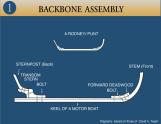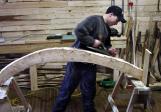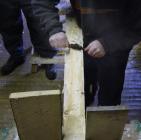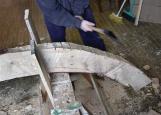1
Backbone assembly2003
Winterton Boat Building and Community Museum, Newfoundland and Labrador, Canada

2
Once decisions were made on the type of boat and design to be used, and all materials were gathered, construction began with preparation of the backbone, which consisted of the keel, stem, sternpost and deadwoods (pieces used to join the stem and stern pieces to the keel).4
The stem was first chopped, using an axe, to get the rough shape and dimensions. The keel and stern post would also be shaped in this manner.6
The axe was one of the most important tools in the traditional boat building process.7
Planing the stem2003
Winterton Boat Building and Community Museum, Newfoundland and Labrador, Canada

8
After the rough dimensions of the keel, stem, and sternpost were achieved using an axe and saw, a plane was used to smooth and finely adjust their shapes.10
The jackplane was essential for smoothing and shaping timber pieces.11
Smoothing timbers2003
Winterton Boat Building and Community Museum, Newfoundland and Labrador, Canada




